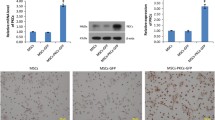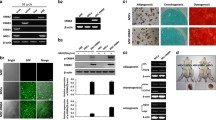Abstract
Objective We aimed to investigate the mechanism mediating the antifibrotic effects of mesenchymal stem cells (MSCs) via in vitro and in vivo study. Methods In vitro, cardiac fibroblasts (CFs) from passage 2 were cultured and incubated with DMEM/F12 supplemented with 10% fetal bovine serum (DM-10), DM-10 containing angiotensin II (Ang II, 1 × 10−6 M) or a combination of MSC-conditioned medium (MSC-CM) and Ang II (1 × 10−6 M) for 48 h. CFs proliferation and gene expression of collagen I and III were analyzed by MTT and reverse transcription-polymerase chain reaction (RT-PCR). In vivo, global heart failure was induced in Wistar rats by isoproterenol (ISO) injection. Four weeks later, MSCs or culture medium were transplanted by intramyocardial injection. Four weeks after transplantation, heart function was assessed, and histological analysis conducted. In addition, the expression of adrenomedullin (ADM), an antifibrotic factor, in MSCs and myocardium were also examined. Results In vitro, MSCs expressed ADM. MSC-CM obviously inhibited CFs proliferation and expression of collagen I and III mRNA. In vivo, compared with medium transplantation, MSC transplantation significantly improved heart function, decreased collagen volume fraction and increased expression of ADM in myocardium. Conclusions MSC transplantation can inhibit function of CFs by secreting antifibrotic factors such as ADM, resulting in decrease of myocardial fibrosis.






Similar content being viewed by others
References
Tang GH, Fedak PW, Yau TM et al (2003) Cell transplantation to improve ventricular function in the failing heart. Eur J Cardiothorac Surg 23:907–916
Fedak PW, Szmitko PE, Weisel RD et al (2005) Cell transplantation preserves matrix homeostasis: a novel paracrine mechanism. J Thorac Cardiovasc Surg 130:1430–1439
Yoshiyama M, Hayashi T, Nakamura Y et al (2004) Effects of cellular cardiomyoplasty on ventricular remodeling assessed by Doppler echocardiography and topographic immunohistochemistry. Circ J 68:580–586
McConnell PI, del Rio CL, Jacoby DB et al (2005) Correlation of autologous skeletal myoblast survival with changes in left ventricular remodeling in dilated ischemic heart failure. J Thorac Cardiovasc Surg 130:1001.e1–1001.e12
Gregory CA, Prockop DJ, Spees JL (2005) Non-hematopoietic bone marrow stem cells: molecular control of expansion and differentiation. Exp Cell Res 306:330–335
Barry FP, Murphy JM (2004) Mesenchymal stem cells: clinical applications and biological characterization. Int J Biochem Cell Biol 36:568–584
Uemura R, Xu M, Ahmad N et al (2006) Bone marrow stem cells prevent left ventricular remodeling of ischemic heart through paracrine signaling. Circ Res 98:1414–1421
Kinnaird T, Stabile E, Burnett MS et al (2004) Local delivery of marrow-derived stromal cells augments collateral perfusion through paracrine mechanisms. Circulation 109:1543–1549
Kudo M, Wang Y, Wani MA et al (2003) Implantation of bone marrow stem cells reduces the infarction and fibrosis in ischemic mouse heart. J Mol Cell Cardiol 35:1113–1119
Nagaya N, Kangawa K, Itoh T et al (2005) Transplantation of mesenchymal stem cells improves cardiac function in a rat model of dilated cardiomyopathy. Circulation 112:1128–1135
Weber KT, Sun Y, Tyagi SC et al (1994) Collagen network of the myocardium: function structural remodeling and regulatory mechanisms. J Mol Cell Cardiol 26:279–292
Samuel CS, Unemori EN, Mookerjee I et al (2004) Relaxin modulates cardiac fibroblast proliferation, differentiation, and collagen production and reverses cardiac fibrosis in vivo. Endocrinology. 145:4125–4133
Li X, Yu X, Lin Q et al (2007) Bone marrow mesenchymal stem cells differentiate into functional cardiac phenotypes by cardiac microenvironment. J Mol Cell Cardiol 42:295–303
Alviano F, Fossati V, Marchionni C et al (2007) Term amniotic membrane is a high throughput source for multipotent mesenchymal stem cells with the ability to differentiate into endothelial cells in vitro. BMC Dev Biol 21:7–11
Guo KT, SchAfer R, Paul A, Gerber A et al (2006) A new technique for the isolation and surface immobilization of mesenchymal stem cells from whole bone marrow using high-specific DNA aptamers. Stem Cells 24:2220–2231
Stewart JA Jr, Cashatt DO, Borck AC et al (2006) 17β-estradiol modulation of angiotensin II-stimulated response in cardiac fibroblasts. J Mol Cell Cardiol 14:97–107
Lijnen P, Papparella I, Petrov V et al (2006) Angiotensin II-stimulated collagen production in cardiac fibroblasts is mediated by reactive oxygen species. J Hypertens 24:757–766
Teerlink JR, Pfeffer JM, Pfeffer MA (1994) Progressive ventricular remodeling in response to diffuse isoproterenol- induced myocardial necrosis in rats. Circ Res 75:105–113
Lijnen P, Papparella I, Petrov V et al (2006) Angiotensin II-stimulated collagen production in cardiac fibroblasts is mediated by reactive oxygen species. J Hypertens 24:757–766
Jugdutt BI (2003) Remodeling of the myocardium and potential targets in the collagen degradation and synthesis pathways. Curr Drug Targets Cardiovasc Haematol Disord 3:1–30
Beltowski J, Jamroz A (2004) Adrenomedullin-what do we know 10 years since its discovery? Pol J Pharmacol 56:5–27
Acknowledgments
This work was supported in part by the National Post-Doctoral Research Fund of China (LRB04-281), by the Natural Scientific Foundation of Heilongjiang Province of China (QC06C056), and by the Grant-in-Aid for Chinese Overseas Scholastic Science Research from the Ministry of Education of Heilongjiang Province (1055HQ016).
Author information
Authors and Affiliations
Corresponding author
Rights and permissions
About this article
Cite this article
Li, L., Zhang, S., Zhang, Y. et al. Paracrine action mediate the antifibrotic effect of transplanted mesenchymal stem cells in a rat model of global heart failure. Mol Biol Rep 36, 725–731 (2009). https://doi.org/10.1007/s11033-008-9235-2
Received:
Accepted:
Published:
Issue Date:
DOI: https://doi.org/10.1007/s11033-008-9235-2




